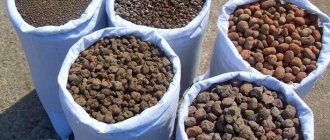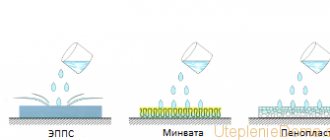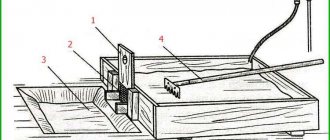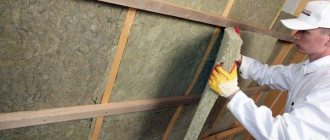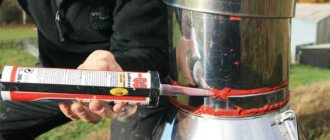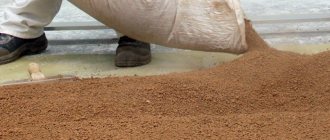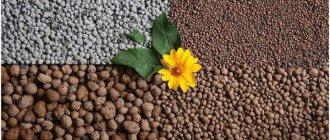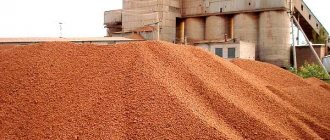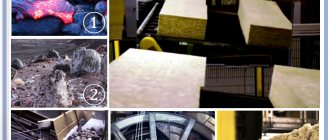Expanded clay - what is it?
We are absolutely sure that anyone over 10 years old knows the mysterious word “expanded clay.”
Many people believe that this is some kind of building material, or drainage felts, or plant bait, or something else... But few will answer the simple question: what is expanded clay? It will be difficult, and please describe the properties of this material. The range of applications is so wide that listing them would take a lot of time. It remains a big mystery where expanded clay is mined or maybe it is produced? And if they are made, then from what? Increasingly, when reviewing heat-insulating materials that have literally flooded our construction markets, the keywords for description are: new, modern, innovative, and so on. Indeed, the quantity, variety, and most importantly the high quality of numerous materials has recently become more and more surprising and pleasing.
Today we will talk about material that is well known from childhood. Let us, so to speak, eliminate the gaps in knowledge. Indeed, expanded clay is primarily a building material, which often finds its use outside the construction site. People who are very far from construction sites sometimes encounter expanded clay balls.
Expanded clay properties application
You don’t have to look far for an example; many have seen pots on windowsills with indoor plants, at the bottom of which small brown balls were placed. So these peas are the mysterious material that we are talking about. And at the bottom of the pot, expanded clay served only the role of excellent drainage for your favorite flowers.
Expanded clay is a lightweight material with a large degree of pores that is widely used in construction. Produced by firing clay. Clay shale is often used for the same purposes. The resulting expanded clay gravel takes on an oval, heterogeneous shape. There is also a concept: expanded clay crushed stone - the only difference between the material is its geometry, the “balls” are more like cubes with sharp edges and uneven corners.
It is not uncommon that the material can be found in the form of expanded clay sand, in which case the balls are very small, they are obtained by crushing, they are less porous and harder. Sand granules often become a constituent material in cement mortars used in construction. Expanded clay is distinguished into three fractions: 5-10 mm, 10-20 mm, 20-40 mm.
Expanded clay is produced from clay rocks containing about 30% quartz and ferrous impurities about 10%, as well as organic inclusions. That is why the material is essentially natural and natural, but it is prepared using an artificial method. Depending on how the clay or shale was fired, expanded clay is obtained with a range of volumetric mass - from 350 to 600 kg/m³ and higher when it comes to expanded clay sand.
Application
The scope of expanded clay is very wide. Products of this type are used for the following purposes:
- Production of expanded clay blocks;
- Sound insulation and insulation of such elements of buildings and structures as roofs, walls, foundations, floors;
- Construction of dams, bridges, roads and other structures;
- Production of “warm” solutions for masonry work;
- Arrangement of drainage elements when growing plants;
- Pipeline insulation;
- Purification of water from various impurities (filtration).
Depending on the type of work and the nature of the problems that need to be solved by using expanded clay, the material of the most suitable fraction is selected. Thus, expanded clay sand, the diameter of the granules of which does not exceed 3 millimeters, is widely used for the preparation of “warm” masonry mortars. This is explained by the fact that the seams are considered the weakest link in terms of thermal resistance. And if a “cold” solution of cement and sand has a high level of thermal conductivity, then replacing it with expanded clay reduces the heat transfer coefficient by almost 3.5 times.
Material fraction 0-5 millimeters is mainly used when making screeds. The use of expanded clay for these purposes makes it possible to create a floor that retains heat much more effectively. The material of this fraction is also used as a filler in the process of manufacturing concrete products for various purposes, when arranging hydroponic and drainage systems in crop production.
Expanded clay gravel, the granule diameter of which is 5-10 millimeters, is one of the most popular. It is used as backfill for gypsum fiber sheets in the process of installing “warm” floors made using German technology, as well as for insulating building facades. In the latter case, expanded clay gravel is mixed with the required amount of cement, after which the resulting composition is poured into the space between the cladding layer and the surface of the load-bearing wall. This thermal insulation is called “capsimet”. Expanded clay of a fraction of 5-10 millimeters is widely used for the manufacture of various concrete products, for example, the resulting material is in the form of building blocks, which have all the advantages of this natural material.
Gravel of a fraction of 10-20 millimeters is an excellent insulation for walls in well masonry, for wooden floors, and roofs. It is also used in the construction of sewer systems, water pipelines and other communications.
A distinctive feature of expanded clay with a granule diameter of 20 to 40 millimeters is its low bulk density compared to gravel of other fractions. In this regard, it is often used as insulation for filling attics, cellars, and foundations, since in such cases there is a need to obtain a large heat-insulating layer. Expanded clay of this fraction is also considered the optimal choice for arranging drainage systems when planting fairly large shrubs and trees.
How is expanded clay made?
The parent of expanded clay, as we have already noticed, is a special clay rock. The essence of the process is based on the well-known property of clay - to swell when heated. Special pyrogenic ovens, similar to drums, which rotate in a circle at a certain angle, are used in the preparation of expanded clay. Raw granules are fired to obtain a certain structure. Clay balls at an angle rush towards the burning torch.
Having received a heat shock of about 1200 degrees, the clay composition boils and swells. On the outside, the material melts and turns brown. Then comes one of the most important steps: cooling. The process consists of several stages. Surely builders know that there is such a term as “soil swelling coefficient”; it is this principle that is incorporated into the magical process of transforming clay mass into expanded clay. The firing itself lasts about 45 minutes.
Expanded clay technical characteristics
The classification of the material is determined by its bulk density, measured in kilograms per cubic meter, ranging from 250 kg to 1000 kg. This indicator is also called volumetric weight and is characterized as the ratio of volume to mass of the material. Expanded clay grades accordingly start with the value M 250 and end with the name M 1000.
Since the oven rotates, the granules take on an almost round shape with a diameter ranging from 0.2-0.4 cm. To make it easier to decide on the brand, it is enough to know the required size:
- fractions of 5-10 mm correspond to a grade of 450-400 kg/m3;
- fractions of 10-20 mm correspond to a grade of 400-350 kg/m3;
- fractions of 20-40 mm correspond to a grade of 350-250 kg/m3.
GOST regulates grades from 250 to M 600. Technical conditions everywhere allow the production of materials with values of M 800 and M 1000. In order not to get completely confused, you should remember a simple rule: lower grade - higher quality.
Expanded clay is one of the top ten organic thermal insulation materials that are constantly in demand in the construction market. The thermal conductivity coefficient strongly depends on the fractions and lies in the range of 0.06-0.17 W/m. The coefficient is characterized by a linear relationship: we reduce the size of the material - we increase the thermal insulation qualities.
Comparative table of thermal conductivity of materials
If the numbers do not provide a clear and understandable understanding of thermal conductivity, then we hope the figure below gives a clearer picture:
Let us add that expanded clay is also characterized by strength. The value varies from P15 to P400. If the number in the value is large, then this indicates better quality. Increased density gives the material correspondingly higher strength. Builders distinguish expanded clay into the following grades:
Expanded clay gravel
- The form is most in demand in the construction industry.
- The grains are spherical, sometimes oblong, irregularly oval in shape; after swelling of the clay they acquire a red-brown color.
- Grains are divided according to the size of the fractions into three groups: 5–10, 10–20 and 20–40 mm;
- It is often included in fillers of various brands of concrete, as it has high strength.
- The thermal conductivity coefficient is the lowest of all types of material. Gravel 10-20 mm grade by bulk density M350 coefficient value is not more than 0.14 W/m.
Expanded clay crushed stone
- Essentially it is crushed expanded clay mass. Large, oversized grains and granules are sent to the crusher, the resulting material is characterized by sharp, uneven edges
- The application does not go beyond filler into concrete mixtures. Crushed stone fraction – 5–40 mm.
Expanded clay sand
- In construction, it is most often used as insulation, with a fine fraction of up to 5 millimeters.
Technical characteristics and material properties
GOST 9757-90 specifies material characteristics that depend on density. This figure ranges from 200 to 800 kg/m3. The brand is also determined by density. Other indicators are determined by the size of the fractions and are presented in the table.
| Characteristic | Fraction size, mm | ||
| 10-20 | 5-10 | 0-5 | |
| Strength grade | M400-M450 | M500-M550 | M600-M700 |
| Bulk density, kg/m3 | 280-370 | 300-400 | 500-700 |
| Weight loss during 20 freezing cycles, % | 0,4-2 | 0,2-1,2 | — |
| Thermal conductivity, W/mK | 0,0912 | 0,0912 | 0,1099 |
| Moisture absorption level, mm | 250 | 250 | 290 |
| Activity of natural radionuclides (specific), Bq/kg | 270 | 270 | 290 |
Technical parameters explain the properties of expanded clay:
- resistance to temperature changes, fire (class NG) and freezing;
- environmentally friendly - thermal insulation does not rot, does not cake or deform;
- high strength, chemical inertness and resistance to acidic environments;
- possibility of use as a decorative material and insulation;
- good sound and heat insulation;
- light weight – ensures ease of transportation.
The material reduces heat loss at home by 50-75%.
Pros and cons of expanded clay
Expanded clay, a porous substance with low weight, is lighter than mineral wool and other foamed polymers, but it is durable. Its weight suggests insulation of the ceilings, since there is no significant load on the ceiling. At the same time, insulating floors followed by cement screed makes the process easier, since during work you can walk on the material without fear for its integrity. The main advantages of expanded clay lie in the following:
- high level of noise and heat insulation. The porous structure resists the propagation of sound waves, and as insulation, the granules work like a thermos;
- low volumetric weight;
- environmental friendliness;
- high resistance to mechanical stress, no rodents are afraid of it;
- expanded clay is completely safe for humans, no larvae grow in it;
- fire-resistant material that does not ignite;
- resistance to negative temperatures, frost resistance of at least 25 cycles;
- has durability, is not prone to rotting, does not form mold or fungi;
- neutral to chemicals;
- simple installation, can be done by one person without construction skills;
- low cost;
- does not decompose over time;
- widely used in growing domestic plants. Expanded clay prevents moisture evaporation, providing control of water balance;
- a popular substrate among gardeners.
With all its advantages, it is worth noting that expanded clay has some disadvantages:
- absorbs water easily, but dries poorly. Because the melted, brown crust is a ceramic coating that prevents drying. Perhaps this is not bad for hydroponics, but it is unacceptable for material - insulation;
- as insulation, it is recommended to fill in expanded clay, without further cement screed;
- good thermal insulation requires a lot of material; the backfill layer must be at least 500 mm.
Application of expanded clay in agriculture
According to most farmers, the material is the best drainage and substrate for crops grown hydroponically.
Expanded clay absorbs moisture when watering and releases it when the soil dries. Quite often, crushed stone and sand are added to optimize air exchange between the plant and the air environment in heavy clay soils.
Drainage, which is based on expanded clay, does not allow the soil to become acidic or silt. At the same time, the material does not weigh down the soil and prevents the formation of mold, moss and fungi.
The material showed itself remarkably well when constructing beds. A layer of 2 - 3 cm poured into its base provides excellent drainage. Gravel scattered between plants retains moisture, performing a mulching role.
Expanded clay has a hard outer shell and a porous core, which makes it a unique organic substrate for hydroponics, a complete soil substitute.
Scope of expanded clay
Due to its low cost and attractive properties, expanded clay is a very popular construction and heat-insulating filler. The material does not require specific skills to work with, it is lightweight, inexpensive, and accessible, which is why its scope of application is unusually wide and varied:
- production of facing and high-hollow ceramic bricks;
- production of expanded clay concrete blocks,
- insulation of floors, walls, attic floors, resulting in a reduction in heat loss by 70%;
- use as a porous aggregate in the production of lightweight concrete.
- everywhere in the construction complex: residential buildings, industrial buildings, country houses and much more, where this inexpensive material is in demand.
- as design solutions in the local area - various paving slabs, bulk structures;
- in agriculture, the water balance indicator stabilizes after the inclusion of expanded clay grains in the soil;
- in wastewater treatment plants, participates in rough cleaning using filters;
Houses built from expanded clay blocks back in the days of the Soviet Union still safely accommodate thousands of families throughout Russia and beyond for more than half a century. In addition to the fact that they have good strength and retain heat well, our climate is also conducive to the use of this frost-resistant and not capricious building material.
Many people remember these structures as “people's construction projects”. In general, it is worth noting that concrete or blocks made with the addition of expanded clay have high strength characteristics and remain light despite their large dimensions.
Scope of expanded clay use
At first it may seem that the scope of construction expanded clay is small, but this is not so. The granules are characterized by excellent thermal conductivity, but a warm home will be cozy. It is this property of the material that allows it to be used for thermal insulation of floors, ceilings, and for attic insulation. At the same time, thermal insulation is not the last useful property of granules.
The advantages of expanded clay include sound insulation and “underlying” properties. Such characteristics indicate that granules can be used as a base when creating a concrete screed. Granules can also be used when filling the foundation during construction work. Thanks to the use of expanded clay, it is possible to reduce the depth of laying the foundation by almost half, which not only saves building materials, but also indicates the possibility of preventing freezing of the ground near the foundation.
This material is often used during the construction of baths - it is necessary for high-quality insulation of floors and walls. And all thanks to the fact that with the help of granules you can achieve a suitable temperature and maintain it for a long time. If you are planning to start laying pipes, you can consider purchasing expanded clay. First of all, you will be sure that the pipes will warm the house and not the ground.
And if an accident occurs, there will be no need to waste time digging up all the ground. The third advantage is that after the repair, you can reuse expanded clay, which will not lose its properties. In addition, this building material is suitable for landscaping garden paths in the vegetable garden or creating a drainage system on the site, which will lead to an increase in productivity. The main thing is to buy small granules.
The use of expanded clay for floor insulation
The sequence of insulation of all types of floors has the same algorithm.
- free the surface from the old coating;
- Seal cracks and cracks with mortar;
- Flooring can be installed directly on an earthen base. First compact the earth, make a cushion of sand and pour gravel.
- Expanded clay must be insulated from moisture with a layer of waterproofing, using, for example, Izospan D.
- pour expanded clay onto the isospan film. Advice from experienced builders says that insulation requires a good layer. It is advisable to form a layer of at least 10 cm.
- Next we lay out the reinforced mesh
- We perform the screed with cement mortar.
- We lay out a vapor barrier - isospan C, then lay a new floor.
If you are insulating the ceiling, then it is better to use expanded clay of two fractions as part of the “pillow”. This technique will allow you to create a denser backfill, which more effectively retains heat in the living space.
In the recent past, it was problematic to buy expanded clay for private use, since it was sold in bulk and in large volumes. It was extremely inconvenient to buy an expanded clay machine, with little need. Nowadays, everything is much simpler and manufacturers pack their goods in bags of different volumes. You can buy expanded clay in packaging in the required quantity without overpaying for extra supplies. The packaging makes transportation easier and will not raise any serious questions.
We offer you an overview of the material in meeting gardening needs:
What is the most profitable way to insulate a wooden house with expanded clay?
The issue of insulating wooden houses, including those with a pile or strip foundation and built using frame-panel technology, today mainly comes down to installing an additional layer of insulation from mineral insulation materials. However, the insulation of a wooden house with expanded clay today is gradually beginning to take center stage due to more accessible technology and the cost of work. The popularity of insulating walls with expanded clay is due to the relatively low cost of work and the excellent technical qualities of expanded clay concrete blocks as the main insulation material.
External or internal insulation?
When considering the insulation of a wooden house with expanded clay, the option most often considered is to install an outer layer of expanded clay concrete blocks followed by plastering the walls. This insulation option is rational when it is possible to install a reliable foundation under a layer of insulation, because, despite the relatively light weight of expanded clay concrete block, a wall made of such blocks has quite an impressive weight.
The construction of the internal layer of insulation of a wooden house with expanded clay is mainly used with half-hollow expanded clay concrete blocks or by filling the cavities between the outer and inner walls with dry expanded clay.
For erected buildings, insulation of walls with expanded clay is carried out from the outside, and, if conditions permit, dry expanded clay is poured into the cavity between the wall and the block or into the voids of the blocks themselves.
A feature of wooden buildings has always been the need to carry out operations to preserve wood, protect it from biological pests and impregnate it with special fire-fighting mixtures. When installing external insulation of a wooden house with expanded clay, the wooden parts must be impregnated before erecting a wall of expanded clay concrete blocks.
For interior work, it is planned to insulate the floor by constructing a cushion of dry expanded clay followed by installing a concrete screed using expanded clay as a filler. The use of expanded clay insulation for the ceiling space is determined by the condition of the ceiling and attic floor.
The use of expanded clay as insulation for wooden buildings will reduce the cost of heating a building by 20-25% just by insulating the walls.
Floor insulation in a frame house on stilts
A pile foundation is a reliable basis for a future frame house, but when insulating the floor, you need to take into account certain rules to avoid drafts under the floor and dampness.
The technology of arranging a foundation on piles is used mainly in swampy areas, where special attention is required to the materials used to obtain strength and resistance to movements of the soil layer. Therefore, thermal insulation is created together with the subfloor, since the layered structure protects the housing from moisture penetration from the foundation.
With a pile foundation, the floor of the first floor is especially not protected from cold and wind. There remains free space between the ground and the ceiling of the first floor. In this case, floor insulation must be done especially carefully. By correctly calculating the thickness of the insulation and accurately performing all the installation work on insulating the floor and basement described in this article, you can get a warm, cozy home even if it is located in a very low temperature zone.
Let's consider expanded clay as insulation, as the cheapest and most environmentally friendly material.
All wooden elements should be treated with an antiseptic to prevent rot.
Floor insulation
The work order is as follows:
- Place logs on the pile foundation grillage.
- Attach 50*50 mm skull blocks to the joists to support the subfloor boards.
- Lay boards or pieces of plywood on top of the skull blocks to create a subfloor.
- Lay waterproofing. The waterproofing tapes should be 10 cm apart from each other, tape the seams. Apply the waterproofing along the perimeter of the floor with edge tape.
- Fill the required layer of expanded clay with a fraction of 10–40 mm. The top layer of expanded clay should not reach the top of the log by 10 cm.
- Fill the top of the expanded clay with a cement screed or lay a vapor barrier film with an overlap of 10 cm and taping the seams.
- Apply final coat.
Base insulation
In a house on stilts, insulation of the basement is of great importance. If the cold and wind do not penetrate the free space under the house between the piles, then heat will be retained much better inside the house.
We arrange the insulation of the base in the same way as the insulation of the wall. Only we place the insulation not only vertically, but also place it under the blind area.
Such insulation of the floor and frame structure on stilts will be inexpensive and will reliably protect the room from frost.
- Under the blind area, compact the soil and place a sand cushion 10 cm thick.
- For the base, make a frame at least 15 cm wide and cover it with boards or plywood panels on the inside.
- Lay a vapor barrier from the blind area to the top of the plinth, taping the seams. Secure it to the boards with a stapler.
- Pour expanded clay onto the blind area along the beacons with a slight slope from the house in a layer of 10–15 cm.
- Make a cement screed over the expanded clay, along the entire blind area.
- After the cement screed has hardened, continue work on insulating the base. Cover the outer part of the plinth with boards or any other finishing to a small height (about 50 cm).
- Lay the waterproofing inside the resulting well with a margin of height up to the top of the plinth and the width of the plinth, attaching it from the inside to the outer wall.
- Pour expanded clay into the well.
- Sew the base up to the top with boards.
- Fill the base with expanded clay to the top.
- Fold the edge of the waterproofing, covering the expanded clay on top, and sew the base on top with boards or trim.
The insulation of the base with expanded clay is completed.
Scheme for insulating the basement of a frame house on stilts
For more information about insulating the floor of a frame house on stilts, see the article “Methods of insulating the floor in a frame house on screw stilts: electric heated floor, water heated floor and others.”
conclusions
Thermal insulation of a frame house is a complex process that requires consistency, care and accuracy. The use of expanded clay allows you to protect the walls and floors of the building, creating a comfortable microclimatic and sanitary-hygienic space.
Expanded clay remains a popular material used as insulation because:
- is relatively cheap;
- easy to install for insulation (unlike sprayed insulation);
- environmentally friendly.
Considering these main advantages of expanded clay, it can be classified as one of the good old materials for insulation, quite affordable and environmentally friendly.
039
Effective sound insulation with expanded clay
A comfortable stay in a room where the sounds of the outside world do not seep through is in many ways today a condition imposed on a living space. However, it often happens that a completely comfortable room suitable for habitation is constantly exposed to sound from the outside or (which is even more common in multi-story buildings) the partitions are so thin that they allow all sounds from the adjacent room to be clearly perceived. There is a way out of this, and it is quite affordable both in price and technology - soundproofing with expanded clay.
Possessing excellent thermal insulation properties, expanded clay also acts as an excellent soundproofing agent: the structure, heterogeneous in shape and weight, perfectly dampens sounds and creates comfort and coziness.
